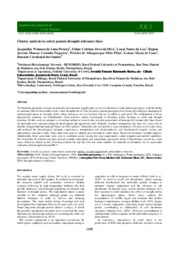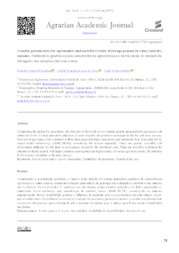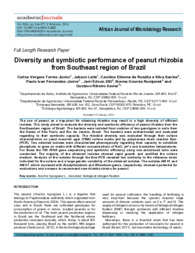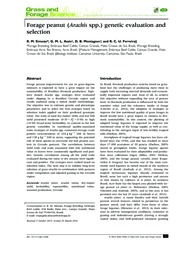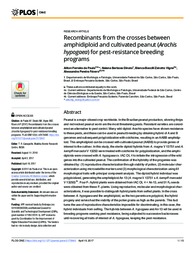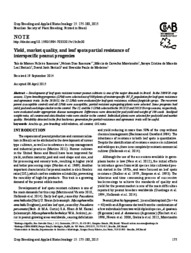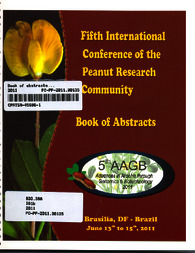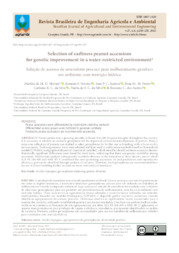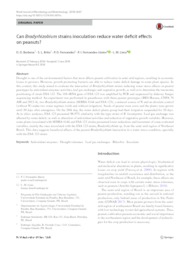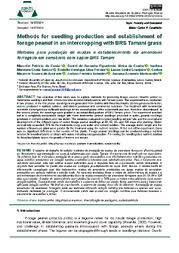Search Publications
Filter by:
| Author(s): PEREIRA, J. W. DE L.; SILVA, E. C. A. DA; NOGUEIRA, R. J. M. C.; MELO FILHO, P. DE A.; LIMA, L. M. de; SANTOS, R. C. dos The breeding programs focused on semiarid environments significantly invest on selection of early-mature genotypes with the ability to maintain yield at reasonable levels, when drought sets in. The fa... ... |
| Author(s): MIQUELONI, D. P.; ASSIS, G. M. L. de; BEBER, P. M. Considering the productive seasonality, the objective of this work was to estimate genetic parameters for agronomic and nutritional traits of forage peanut for selection of more adapted and productive... ... |
| Author(s): TORRES JÚNIOR, C. V.; LEITE, J.; SANTOS, C. E. de R. e S.; FERNANDES JUNIOR, P. I.; ZILLI, J. E.; RUMJANEK, N. G.; XAVIER, G. R. The use of peanut as a trap-plant for obtaining rhizobia may result in a high diversity of efficient isolates. This study aimed to evaluate the diversity and symbiotic efficiency of peanut rhizobia fr... ... |
| Author(s): RESENDE, R. M. S.; ASSIS, G. M. L. de; MONTAGNER, D. B.; FERREIRA, R. C. U. Forage peanut improvement for use in grass-legume mixtures is expected to have a great impact on the sustainability of Brazilian livestock production. Eighteen cloned Arachis spp. ecotypes were evalua... ... |
| Author(s): PAULA, A. F. de; DINATO, N. B.; VIGNA, B. B. Z.; FAVERO, A. P. Peanut is a major oilseed crop worldwide. In the Brazilian peanut production, silvering thrips and red necked peanut worm are the most threatening pests. Resistant varieties are considered an alternat... ... |
| Author(s): SUASSUNA, T. de M. F.; SUASSUNA, N. D.; MORETZSOHN, M. de C.; BERTIOLI, S. C. de M. L.; BERTOLI, D. J.; MEDEIROS, E. P. de Development of leaf spots resistant runner peanut cultivars is one of the major demands in Brazil. In the 2009/10 crop season, 12 pre-breeding progenies (LPM) were selected out of 380 plants of an int... ... |
| Author(s): GUIMARAES, P. M.; BRASILEIRO, A. C. M.; MORGANTE, C. V.; ROBERTS, P. A.; PAPPAS JUNIOR, G. J.; SILVA JUNIOR, O. B. da; BERTIOLI, S. C. de M. L.; MARTINS, A.; BERTIOLI, D. This study should facilitate basic and applied research on the genetics and evolutionary studies of peanut, contribute to the development of molecular markers for other legumes and facilitate comparat... ... |
| Author(s): MORAIS, M. de M. D.; PEREIRA, R. F.; RAMOS, J. P. C.; FREIRE, R. M. M.; SILVA, C. R. C. da; SILVA, M. de F. C. da; SANTOS, R. C. dos Peanut production is growing annually in Brazil, but with frequent droughts throughout the country, it is necessary to identify an earliness germplasm for the improved environmental adaptation of pean... ... |
| Author(s): BARBOSA, D. D.; BRITO, S. L.; FERNANDES, P. D.; FERNANDES JUNIOR, P. I.; LIMA, L. M. de Drought is one of the environmental factors that most affects peanut cultivation in semi-arid regions, resulting in economic losses to growers. However, growth promoting bacteria are able to reduce wa... ... |
| Author(s): COSTA, M. P. da; CUNHA, D. de N. F. V. da; TARÔCO, I. M, C.; PEREIRA, R. H. S. The objective of this study was to explore methods for producing forage peanut (Arachis pintoi) cv. Belomonte seedlings and their introduction into an established pasture with Tamani grass |
Observation
Some of Embrapa's publications are published as ePub files. To read them, use or download one of the following free software options to your computer or mobile device. Android: Google Play Books; IOS: iBooks; Windows and Linux: Calibre.
Access other publications
Access the Agricultural Research Database (BDPA) to consult Embrapa's full library collection and records.
Visit Embrapa Bookstore to purchase books and other publications sold by Embrapa.

